Baseball Diamond Diagram: Setting Field Up
Baseball Diamond Diagram Set Up - Here's some tips you'll need if the baseball association you belong to does not require the umpires to set the field up for the game, or maintain a staff which grooms the fields and sets the field up. Some associations require the coach to set up the field.
Should that be your case you’ll need the minimum following equipment to add to your duffle bag. A 100’ tape measure, a hammer, two small thin screw drivers and a ball of twine or string.
Let’s discuss an actual setting up technique.
There are a few basics, which for some reason is constantly misunderstood, which will help you immensely and keep you from appearing foolish or mentally challenged.
Tip one, measurements to first base, third base and the pitcher’s rubber are taken from the back point of home plate.
Tip two, first and third base are located inside the foul line. The base does not straddle the line ! More than once I’ve seen bases straddling the foul line and it drives me nuts.
First, it’s wrong …but more importantly invariably you’ll have a hard hit grounder which will cross the base in what should be foul territory, which the umpire will call fair because it crossed over the base. Believe me Murphy’s Law will apply here and 99% of the time the call will go against you, not for you.
If you’re really unlucky it could cost you the base game.
If you see this and can talk to umpire before the game starts by all means do so. If not possible prior to the game be sure to bring it up when you go over the ground rules with the umpire and opposing coach at home plate. I’ll get off my griping soapbox now. Onward to important matters.
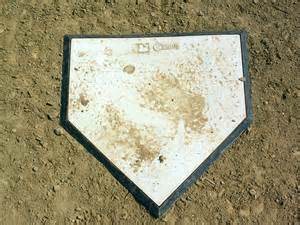
Baseball Diamond Diagram - Measure From Back Point
Tip two, first and third base are located inside the foul line. The base does not straddle the line ! More than once I’ve seen bases straddling the foul line and it drives me nuts.
First, it’s wrong …but more importantly invariably you’ll have a hard hit grounder which will cross the base in what should be foul territory, which the umpire will call fair because it crossed over the base. Believe me Murphy’s Law will apply here and 99% of the time the call will go against you, not for you.
If you’re really unlucky it could cost you the base game.
If you see this and can talk to umpire before the game starts by all means do so. If not possible prior to the game be sure to bring it up when you go over the ground rules with the umpire and opposing coach at home plate. I’ll get off my griping soapbox now. Onward to important matters.
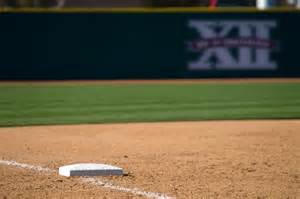
Baseball Diamond Diagram - Bases In Fair Territory
The first step in setting up a baseball diamond is placement of the bases at the proper distance and striping the baselines. All of your measurements will be taken from the rear tip of home plate.
Baseball Diamond Diagram Set Up
Stick a screwdriver, hammer it in if the ground is too hard, at the rear tip of home plate. Tie a string around the screwdriver and unwinding it as you walk down the first base line, continue until you reach the existing foul line. ( every league I’ve ever been involved with establish foul lines through the outfield to a foul pole. This is done in many different ways, from heavily chalking the line to killing the grass. )
Stick the second screwdriver into the ground as close as possible to the middle of the foul line. Pull the string taunt and tie it off to the screwdriver. This will give you a straight baseline that will match up to the foul line.
As you walk the chalking machine down the baseline use the string line as a center line, chalking past the infield until you connect with the established foul line. This will give you a straight clean baseline which will look professional. Repeat this procedure for the third baseline.
Detach and roll up the string, replacing it with your 100’ tape measure.( When you buy your tape make sure it has an end attachment which allows you stick a screwdriver through it )
Unwind the tape measure down the foul line, either stopping at the designated distance or running past it. Mark the proper distance in the dirt. Install the base at the center of the designated distance and inside the foul line. Repeat this procedure for the third base installation.
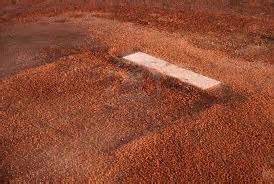
Another Baseball Diamond Diagram Tip:
Installing second base is a bit more tricky. Stick your screwdriver into the ground as close as possible to the center and back side of first base. Using your tape measure stretch it out to the proper distance and draw a 1’ to 2’ line in the dirt.
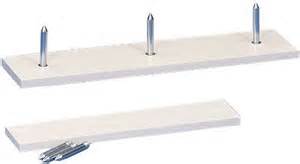
I Suggest 3 Spiked Rubber Instead Of 4 As The 4th Usually Gets Bent
Repeat this procedure from third base. When you finish marking your second line the two lines should intersect. Install your base inside the lines of the criss cross using it for a template.
You now have the foul lines clearly marked and the bases installed in their proper places. Take a second for a quick survey glance to make sure you didn’t make a glaring mistake. ( we’re all capable of mistakes )
Clickbank Products
Lastly comes the installation of the pitching rubber. Attach your tape to the home plate screwdriver. Unwind your tape all the way to second base and leave it laying on the base.
Place the pitcher rubber at the proper distance, don’t install yet. Walk behind home plate and eyeball the pitchers’ rubber to insure it’s centered with second base. If not, just realign it until it’s centered, then install.
Since all youth league ball parks are different, you’ll have to eyeball the on-deck batters’ circle. Eyeball and run a quick 1st & 3rd base coaching box.
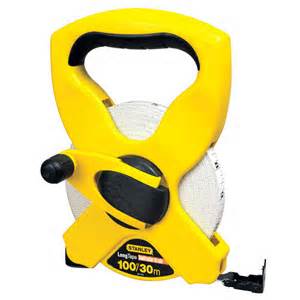
Baseball Diamond Diagram - 100' Tape
Baseball Diamond Diagram Set Up Tip:
Outlining a batters box around home plate is a bit tedious and I wouldn’t recommend doing it until your players are at least age 14. And then only for tournament or championship games.
That’s it. Your Diamond set up is finished and you have a professional looking job which makes the game easy to umpire and has the kids feeling professional.
There are a lot of issues associated with maintaining a baseball park, little league up to MLB. I've included an assortment of baseball park, equipment and training tools for you to review as the need arises or just for your general knowledge.
Baseball Diamond Diagram Back To Baseball Diamond

New! Comments
Have your say about what you just read! Leave me a comment in the box below.